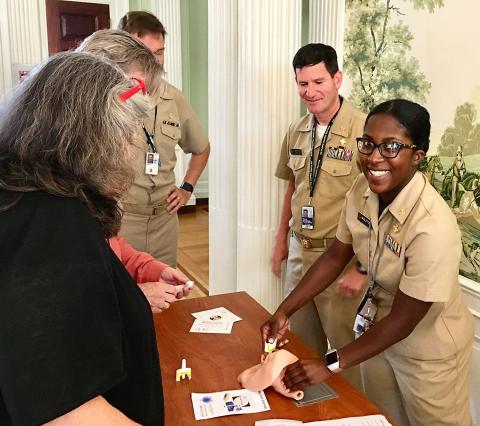NIH Learns How to Use Naloxone, Save Lives

Photo: Peter Kilmarx
Public Health Service officers at NIH have trained more than 150 officers and others at NIH in opioid overdose response and use of naloxone.
In response to the nationwide epidemic of opioid overdoses and death, Surgeon General Jerome Adams issued an advisory in April urging more Americans to carry the lifesaving medication naloxone, which can reverse the effects of an opioid overdose. A dozen PHS Commissioned Corps officers from eight ICs answered the call by forming a working group to develop a program to train others at NIH and in the community.
Recently, 45 NIH officers were trained and certified as opioid response trainers by Dr. Al Romanosky, medical director/state emergency preparedness coordinator of the Maryland department of health’s Office of Preparedness and Response.
These NIH PHS officers then held a marathon training session a few weeks later at Stone House. Four 90-minute training sessions were held throughout the day. Trainees were briefed on the current opioid crisis, how to recognize the signs and symptoms of an opioid overdose, how naloxone works and how to administer the medication. Following the lecture, attendees were divided into small groups for hands-on skill training. In the break-out groups, trainees were given scenarios to assess their ability to recognize signs and symptoms of an opioid overdose and given test kits to administer the naloxone in three different available forms. By the end of the day, 153 individuals were trained in administering naloxone; 34 of them were also trained and certified as trainers. Attendees included staff from the NIH Fire and Police Departments and interest extended beyond NIH’s walls with participants from the Food and Drug Administration, the Centers for Medicare and Medicaid Services, the Department of Defense, the Health Resources and Services Administration and the Office of the Secretary.
“The response by the NIH PHS officers has been outstanding,” said Radm. Peter Kilmarx, FIC’s deputy director, who helped lead the training initiative. “We’re proud to have a meaningful and visible role in responding to the surgeon general’s advisory and are planning to extend the training to others at NIH and in the community.”
Romanosky noted, “We’re very pleased with this relationship with the PHS officers. I was truly impressed by their dedication and drive and see this as a model of collaboration.”
Opioids are a class of drugs that include prescription pain relievers, heroin and synthetic opioids such as fentanyl. Naloxone is an opioid antagonist that is used to temporarily reverse the effects of an opioid overdose and can potentially save a life. More than 2 million people in the U.S. struggle with an opioid use disorder. Rates of opioid drug deaths are rapidly increasing, reaching 49,000 in 2017.
